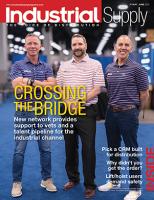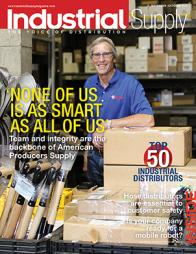The Future of Industrial Cybersecurity
By Eric Sugar
In an era marked by the relentless march of digitalization and the increasing interconnectivity of industrial systems, the landscape of cybersecurity has been thrust into the spotlight. The traditional paradigms of network security, once considered impervious, have proven insufficient in the face of ever-evolving cyber threats. It is in this crucible of change and challenge that a revolutionary concept has emerged: Zero Trust Architecture (ZTA).
 In a world where trust can no longer be taken for granted, ZTA heralds a profound shift in the way we safeguard our critical infrastructure and industrial systems. It assumes zero trust — even within the confines of the internal network — paving the way for a new era in cybersecurity. It’s important to understand how ZTA will impact real-world principles and practices, and how it’s irrevocably shaping the future of industrial cybersecurity.
In a world where trust can no longer be taken for granted, ZTA heralds a profound shift in the way we safeguard our critical infrastructure and industrial systems. It assumes zero trust — even within the confines of the internal network — paving the way for a new era in cybersecurity. It’s important to understand how ZTA will impact real-world principles and practices, and how it’s irrevocably shaping the future of industrial cybersecurity.
Demystifying zero trust: what it means for security
The traditional model of network security, often encapsulated by the phrase "trust but verify," has been the cornerstone of cybersecurity for decades. In this model, once a user and device are inside the perimeter of a network, there's often a presumption of trust. This assumption is based on the idea that a well-defended perimeter can protect an organization's critical assets and sensitive data. However, the evolving threat landscape has cast doubts on this paradigm, revealing its vulnerabilities.
Enter ZTA, a concept that questions the very foundation of trust in the world of cybersecurity. ZTA embraces the radical notion of "never trust, always verify." It asserts that trust is a scarce and fragile commodity — one that should be granted not on the basis of position or credentials, but on the continuous verification of identity, security posture, and behavior.
The core tenets of Zero Trust can be distilled into several key principles:
- No Implicit Trust: In ZTA, trust is never assumed based on location or network access. Whether a user or device is inside or outside the network perimeter, the default posture is one of skepticism. This change fundamentally shifts the traditional security mindset.
- Continuous Verification: Trust is a dynamic state in a Zero Trust model. Users and devices must continually prove their legitimacy and security status, rather than rely on a one-time authentication process.
- Least Privilege Access: Access is granted on a need-to-know basis, ensuring that users and devices have the minimal access required to perform their functions. This reduces the attack surface by limiting potential points of compromise.
- Micro-Segmentation: Networks are divided into smaller, isolated segments, limiting attackers' lateral movement. This containment strategy is a powerful tool for reducing the impact of security breaches.
- Identity-Centric Security: Identity and access management (IAM) become paramount in ZTA. Robust IAM systems ensure that only authorized individuals gain access to specific resources.
- Multi-Factor Authentication (MFA): MFA adds an extra layer of security by requiring multiple forms of authentication, making it more challenging for unauthorized users to gain access.
- Continuous Monitoring: Real-time monitoring of user and device behavior is essential for ZTA. Any anomalies or deviations from established baselines are swiftly identified, enabling rapid response to potential security threats.
By shifting from a trust-based security model to one of continuous verification, ZTA significantly reduces the attack surface, making it harder for attackers to infiltrate networks and compromise critical assets. Furthermore, this approach aligns well with compliance requirements and regulations, providing organizations with a proactive strategy for safeguarding their digital assets.
Implementing ZTA: Benefits and best practices
Implementing zero trust architecture successfully requires careful planning and execution. To start, organizations should thoroughly classify their data and assets based on criticality and sensitivity. This allows tailored protections to be defined for different access tiers. The network environment itself needs to be segmented into zones with strict boundaries between them to limit lateral attacker movement. Enforcing robust user authentication through single sign-on and multifactor authentication enhances identity assurance in line with zero trust principles. Orchestrating access through automated provisioning and deprovisioning further minimizes the attack surface by preventing accumulation of unnecessary access. Continuous monitoring of all access requests and user activities through comprehensive logging and analysis allows threat detection. To maintain security, regular patching, configuration updates and access revocation should become standard procedures.
Following these best practices in architecture and implementation allows organizations to maximize the risk reduction and visibility benefits of zero trust architecture for securing modern industrial environments. The focus is on securing access through identity/context-based policies, segmenting networks, enhancing authentication and monitoring vigilantly.
The future of security: Continuous verification and beyond
While zero trust architecture represents a major evolution in cybersecurity, additional innovations on the horizon will further enhance protections for industrial environments. One emerging capability is continuous verification of identities and system integrity through ongoing monitoring and analysis.
Continuous verification leverages technologies like user behavior analytics and endpoint detection and response. By continuously analyzing patterns and anomalies, threats can be identified in real-time based on changes in user or system behaviors. For example, credentials being used from an unusual location or device could trigger an alert. This provides a significant advantage over periodic compliance checks or audits.
Looking even further ahead, technologies like artificial intelligence, machine learning and automation will enable industrial cybersecurity to move from passive defense to active prevention. By combining massive threat intelligence and the ability to take instant action, attacks could be autonomously predicted, detected and blocked in real-time. Human security teams would focus more on overall strategy, governance and complex response.
The future of industrial security will also be defined by a holistic risk-based approach spanning IT, OT, IoT and physical systems. As environments become more connected and complex, siloed security will no longer suffice. Hyper-convergence of identities, devices, networks, clouds and applications will mandate unified cyber-physical protection.
While challenges remain, innovations like zero trust, continuous verification, and AI-driven automation point toward an era of rapid threat detection and automated prevention. By preparing now, industrial organizations can position themselves to embrace the future of cybersecurity and resilience.
 Eric Sugar is the president of ProServeIT. With over 20 years of experience working in the information technology and services industry, he cares deeply about helping businesses become digital and maintaining digital data security.
Eric Sugar is the president of ProServeIT. With over 20 years of experience working in the information technology and services industry, he cares deeply about helping businesses become digital and maintaining digital data security.














